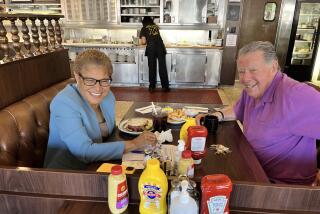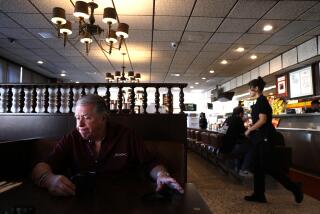Urban Decay Is Brewing Trouble in Milwaukee : Cities: Poverty, unemployment, teen-age pregnancy and crime are among conditions that continue to worsen in the inner city.
MILWAUKEE — The $25 Mario Smith earns from giving blood plasma twice a week won’t shield him from the winter winds off Lake Michigan or replace the regular income he once received as a gas station attendant.
Smith, 24, came to Milwaukee from Mississippi with the hope of finding better living conditions. But as he waited his turn at a plasma donation center, he said the bleak job prospects and poverty in Milwaukee’s inner city have left him few alternatives.
Scores of residents line up daily at the three donor centers located on one block on the city’s mostly black north side.
“The employment conditions are so bad that this is one of the only ways to make an income,” Alderman Michael McGee said. “It’s like going to cows in a barn and milking them. They milk them down, and they come back next week.”
Beneath the facade of Milwaukee’s world-famous breweries and once-powerful manufacturers lie serious problems that are festering almost exclusively in the city’s black community.
The city’s homicide rate has doubled since 1988 and more than tripled since 1984. Three-fourths of the record 165 homicide victims in 1990 were black, even though blacks make up only 27% of the city’s population.
Black unemployment in the city is nearly five times the state average of 4.2%.
The city also has the lowest median income for black families in the nation among cities of comparable size, the highest percentage of single-parent families and the highest rate of births to black teen-agers. It is second in the nation in the percentage of black males incarcerated.
These problems have left Milwaukee, a city of 600,000 perched on the western shores of Lake Michigan, grappling with a crisis once unique to Chicago, Los Angeles and New York.
“It’s a city with problems of considerable proportions. My impression is that it’s in pretty grim shape,” said Walter Morrison, a member of the executive staff of the National Assn. for the Advancement of Colored People in Baltimore.
“It would shock an awful lot of people if an explosive situation took place in Milwaukee,” said Morrison, a former resident of the city. “People don’t expect it to happen there.”
The severity of Milwaukee’s urban crisis, and its uniqueness among cities its size, has focused national attention on McGee’s “politics of bloodshed,” particularly his promise to launch violent terrorist attacks in 1995 if conditions in the black community don’t improve.
The alderman, one of only three blacks on the 16-member City Council, has formed a Black Panther Militia he says already has 200 members and is training to carry out terrorist attacks.
McGee is demanding that the city spend $100 million to create new jobs in the inner city, redraw the aldermanic districts to increase minority representation and implement other recommendations made by a task force he led that studied unemployment, crime, teen pregnancy and other problems plaguing the black community.
McGee’s demands, however, have been overshadowed by his antics, including a threat to disrupt the city’s circus parade and a warning that a black militant group had poisoned a sausage maker’s products. The maker was forced to recall 80,000 pounds of meat, but no evidence of poison was found. The City Council formally censured McGee for igniting a false scare.
McGee, labeled a “demented fool” by Mayor John O. Norquist, said the public and news media have misinterpreted his actions, which are aimed at calling attention to the plight of the inner city.
“There’s been so much hoopla about 1995 that nobody’s dealing with 1990,” he said.
Norquist declined six requests by a reporter for interviews. An aide, Steve McKay, said the mayor did not want to be quoted in a story about negative aspects of the city.
Little action has been taken on the recommendations of the Black Community Relief Task Force, commissioned by the City Council to study Milwaukee’s problems.
The task force completed its work in 1989, making 43 recommendations addressing such issues as teen-age pregnancy, the spiraling homicide rate and black joblessness.
Conditions continue to worsen. The homicide rate in Milwaukee last year stood at about 25 per 100,000, up from 18.7 in 1989, 11.7 in 1988 and 7.3 in 1984. Milwaukee is one of the few small cities with a homicide rate comparable to Chicago, New York and Los Angeles, according to FBI statistics.
The unemployment level in the inner city last fall reached as high as 26%. In 1989, it stood at 20%, in contrast to a statewide rate that most recently dipped to 3.8%.
Many officials blame the high joblessness on the loss of about one-third of the city’s well-paying manufacturing jobs during the early 1980s. Over the last decade, three of the city’s main breweries --Schlitz, Blatz and Pabst--have been either closed or severely downgraded. Other manufacturers have closed or scaled down.
Former Mayor Henry Maier, who stepped down in 1988 after 28 years in office, said he warned of conditions in the inner city but that residents and other leaders “turned a deaf ear” to proposals that would have economically and racially diversified the central city.
“I kept trying to spell out what was happening to us in terms of the employment in the central area, and people just didn’t care,” Maier said. “This thing is coming to a climax, and we’re seeing the effects of that just now.”
In McGee’s district, the remains of a once-vibrant commercial area are evident everywhere. Most stores and factories are abandoned, and the few that aren’t are protected by iron grates. Graffiti covers many walls, garage doors and storefronts, marking off territory for gangs in the city’s increasingly violent youth war.
But some groups are making efforts to improve conditions.
Two anti-crime groups’ efforts to educate teen-agers about drugs and organize crime watch programs have won the praise of President Bush, and the city’s clergy have formed a powerful lobby to push an inner-city improvement agenda.
“We’ve had enough and now it’s time for someone to listen,” said Queen Hyler, a mother who formed the Stop the Violence anti-crime group after her teen-age son was attacked randomly by a youth gang and beaten. “We’re going to launch a campaign like this city has never seen before.”
To McGee, however, the efforts thus far have been “patchwork.” City officials must respond with sweeping initiatives that address everything from teen pregnancies to poor housing and unemployment, he said.
“I keep saying we have to quit playing games,” McGee said. “It’s time now to get off our tails, spend the money now and do something about it.”
More to Read
Sign up for Essential California
The most important California stories and recommendations in your inbox every morning.
You may occasionally receive promotional content from the Los Angeles Times.










